Zhifan Ye
Omni-Recon: Towards General-Purpose Neural Radiance Fields for Versatile 3D Applications
Mar 17, 2024Abstract:Recent breakthroughs in Neural Radiance Fields (NeRFs) have sparked significant demand for their integration into real-world 3D applications. However, the varied functionalities required by different 3D applications often necessitate diverse NeRF models with various pipelines, leading to tedious NeRF training for each target task and cumbersome trial-and-error experiments. Drawing inspiration from the generalization capability and adaptability of emerging foundation models, our work aims to develop one general-purpose NeRF for handling diverse 3D tasks. We achieve this by proposing a framework called Omni-Recon, which is capable of (1) generalizable 3D reconstruction and zero-shot multitask scene understanding, and (2) adaptability to diverse downstream 3D applications such as real-time rendering and scene editing. Our key insight is that an image-based rendering pipeline, with accurate geometry and appearance estimation, can lift 2D image features into their 3D counterparts, thus extending widely explored 2D tasks to the 3D world in a generalizable manner. Specifically, our Omni-Recon features a general-purpose NeRF model using image-based rendering with two decoupled branches: one complex transformer-based branch that progressively fuses geometry and appearance features for accurate geometry estimation, and one lightweight branch for predicting blending weights of source views. This design achieves state-of-the-art (SOTA) generalizable 3D surface reconstruction quality with blending weights reusable across diverse tasks for zero-shot multitask scene understanding. In addition, it can enable real-time rendering after baking the complex geometry branch into meshes, swift adaptation to achieve SOTA generalizable 3D understanding performance, and seamless integration with 2D diffusion models for text-guided 3D editing.
GPT4AIGChip: Towards Next-Generation AI Accelerator Design Automation via Large Language Models
Sep 19, 2023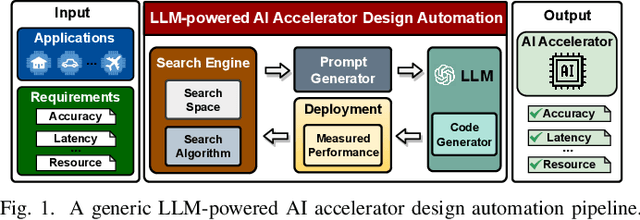
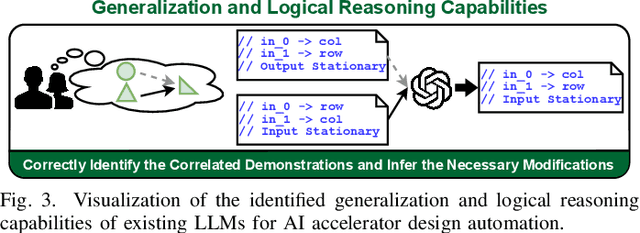
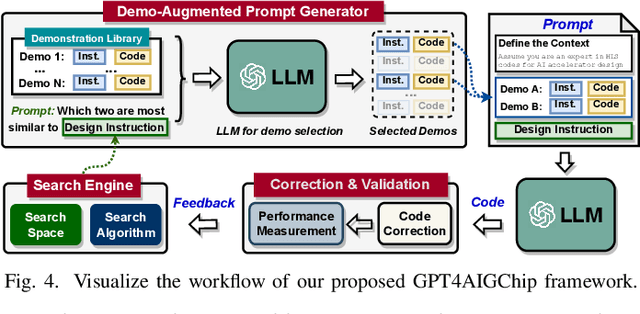

Abstract:The remarkable capabilities and intricate nature of Artificial Intelligence (AI) have dramatically escalated the imperative for specialized AI accelerators. Nonetheless, designing these accelerators for various AI workloads remains both labor- and time-intensive. While existing design exploration and automation tools can partially alleviate the need for extensive human involvement, they still demand substantial hardware expertise, posing a barrier to non-experts and stifling AI accelerator development. Motivated by the astonishing potential of large language models (LLMs) for generating high-quality content in response to human language instructions, we embark on this work to examine the possibility of harnessing LLMs to automate AI accelerator design. Through this endeavor, we develop GPT4AIGChip, a framework intended to democratize AI accelerator design by leveraging human natural languages instead of domain-specific languages. Specifically, we first perform an in-depth investigation into LLMs' limitations and capabilities for AI accelerator design, thus aiding our understanding of our current position and garnering insights into LLM-powered automated AI accelerator design. Furthermore, drawing inspiration from the above insights, we develop a framework called GPT4AIGChip, which features an automated demo-augmented prompt-generation pipeline utilizing in-context learning to guide LLMs towards creating high-quality AI accelerator design. To our knowledge, this work is the first to demonstrate an effective pipeline for LLM-powered automated AI accelerator generation. Accordingly, we anticipate that our insights and framework can serve as a catalyst for innovations in next-generation LLM-powered design automation tools.
Gen-NeRF: Efficient and Generalizable Neural Radiance Fields via Algorithm-Hardware Co-Design
Apr 25, 2023

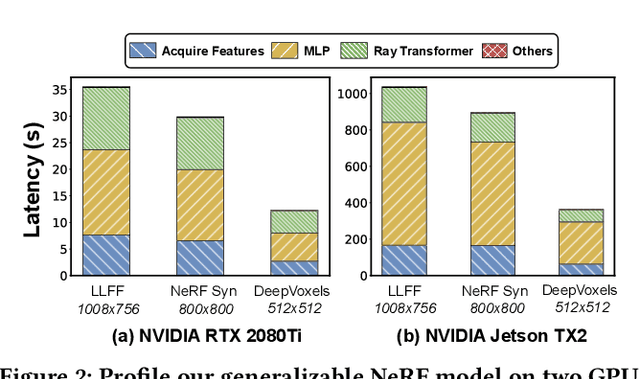
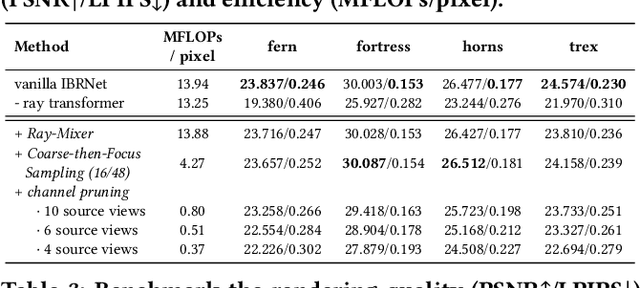
Abstract:Novel view synthesis is an essential functionality for enabling immersive experiences in various Augmented- and Virtual-Reality (AR/VR) applications, for which generalizable Neural Radiance Fields (NeRFs) have gained increasing popularity thanks to their cross-scene generalization capability. Despite their promise, the real-device deployment of generalizable NeRFs is bottlenecked by their prohibitive complexity due to the required massive memory accesses to acquire scene features, causing their ray marching process to be memory-bounded. To this end, we propose Gen-NeRF, an algorithm-hardware co-design framework dedicated to generalizable NeRF acceleration, which for the first time enables real-time generalizable NeRFs. On the algorithm side, Gen-NeRF integrates a coarse-then-focus sampling strategy, leveraging the fact that different regions of a 3D scene contribute differently to the rendered pixel, to enable sparse yet effective sampling. On the hardware side, Gen-NeRF highlights an accelerator micro-architecture to maximize the data reuse opportunities among different rays by making use of their epipolar geometric relationship. Furthermore, our Gen-NeRF accelerator features a customized dataflow to enhance data locality during point-to-hardware mapping and an optimized scene feature storage strategy to minimize memory bank conflicts. Extensive experiments validate the effectiveness of our proposed Gen-NeRF framework in enabling real-time and generalizable novel view synthesis.
ViTALiTy: Unifying Low-rank and Sparse Approximation for Vision Transformer Acceleration with a Linear Taylor Attention
Nov 09, 2022Abstract:Vision Transformer (ViT) has emerged as a competitive alternative to convolutional neural networks for various computer vision applications. Specifically, ViT multi-head attention layers make it possible to embed information globally across the overall image. Nevertheless, computing and storing such attention matrices incurs a quadratic cost dependency on the number of patches, limiting its achievable efficiency and scalability and prohibiting more extensive real-world ViT applications on resource-constrained devices. Sparse attention has been shown to be a promising direction for improving hardware acceleration efficiency for NLP models. However, a systematic counterpart approach is still missing for accelerating ViT models. To close the above gap, we propose a first-of-its-kind algorithm-hardware codesigned framework, dubbed ViTALiTy, for boosting the inference efficiency of ViTs. Unlike sparsity-based Transformer accelerators for NLP, ViTALiTy unifies both low-rank and sparse components of the attention in ViTs. At the algorithm level, we approximate the dot-product softmax operation via first-order Taylor attention with row-mean centering as the low-rank component to linearize the cost of attention blocks and further boost the accuracy by incorporating a sparsity-based regularization. At the hardware level, we develop a dedicated accelerator to better leverage the resulting workload and pipeline from ViTALiTy's linear Taylor attention which requires the execution of only the low-rank component, to further boost the hardware efficiency. Extensive experiments and ablation studies validate that ViTALiTy offers boosted end-to-end efficiency (e.g., $3\times$ faster and $3\times$ energy-efficient) under comparable accuracy, with respect to the state-of-the-art solution.
Losses Can Be Blessings: Routing Self-Supervised Speech Representations Towards Efficient Multilingual and Multitask Speech Processing
Nov 02, 2022Abstract:Self-supervised learning (SSL) for rich speech representations has achieved empirical success in low-resource Automatic Speech Recognition (ASR) and other speech processing tasks, which can mitigate the necessity of a large amount of transcribed speech and thus has driven a growing demand for on-device ASR and other speech processing. However, advanced speech SSL models have become increasingly large, which contradicts the limited on-device resources. This gap could be more severe in multilingual/multitask scenarios requiring simultaneously recognizing multiple languages or executing multiple speech processing tasks. Additionally, strongly overparameterized speech SSL models tend to suffer from overfitting when being finetuned on low-resource speech corpus. This work aims to enhance the practical usage of speech SSL models towards a win-win in both enhanced efficiency and alleviated overfitting via our proposed S$^3$-Router framework, which for the first time discovers that simply discarding no more than 10\% of model weights via only finetuning model connections of speech SSL models can achieve better accuracy over standard weight finetuning on downstream speech processing tasks. More importantly, S$^3$-Router can serve as an all-in-one technique to enable (1) a new finetuning scheme, (2) an efficient multilingual/multitask solution, (3) a state-of-the-art ASR pruning technique, and (4) a new tool to quantitatively analyze the learned speech representation. We believe S$^3$-Router has provided a new perspective for practical deployment of speech SSL models. Our codes are available at: https://github.com/GATECH-EIC/S3-Router.
 Add to Chrome
Add to Chrome Add to Firefox
Add to Firefox Add to Edge
Add to Edge